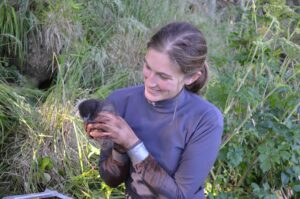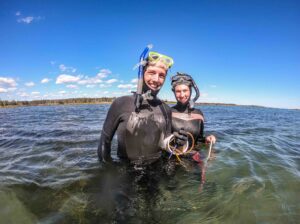Volunteer of the Month: Katie Studholme
18 Apr 2021
This month we’re proud to introduce Katie Studholme, who has been contributing her scientific and analytical expertise to help our stewardship team’s work on property baselines.
Katie grew up in Virginia and spent every summer on the coast of Maine. “It was a nice contrast – fall and winter in the woods, summer on the coast. Both environments contributed to me becoming the person I am today,” says Katie. “I had a lot of free rein as a kid – my mom was even okay with me learning a couple things I could find and eat safely. It was good to have physical and other space to explore.”
Katie always knew she wanted to study biology; while her undergraduate research focused on marine biology, it led her to want to work on things at a more macro scale. “I was working with marine bacteria and viruses,” she says. “It was interesting, but I didn’t enjoy being in a dark lab behind a microscope looking at a bunch of glowing dots.”
 She started to look for overlapping interests that could help her transition to a broader focus. “I had an uncle who did volunteer raptor banding, which I had gotten to help with a few times when I was young” – fast forward through two years of field work with seabirds and shorebirds, and Katie moved to Halifax to complete a graduate degree at Dalhousie with seabird research. She explains that her study system was on the west coast, so even though she was living here, she was spending most of her time “behind a computer and thinking about a different environment.” So when she finished grad school, she went looking for opportunities to give back and learn about the environment where she had been living.
She started to look for overlapping interests that could help her transition to a broader focus. “I had an uncle who did volunteer raptor banding, which I had gotten to help with a few times when I was young” – fast forward through two years of field work with seabirds and shorebirds, and Katie moved to Halifax to complete a graduate degree at Dalhousie with seabird research. She explains that her study system was on the west coast, so even though she was living here, she was spending most of her time “behind a computer and thinking about a different environment.” So when she finished grad school, she went looking for opportunities to give back and learn about the environment where she had been living.
She volunteered to help with a Nature Trust event in 2019 and quickly began contributing her research and analytical skills to our stewardship work. She spent this past winter helping edit property baselines, determining how best to represent and communicate the relevant scientific information in an accessible way. “Some of the properties have just so much data and an incredible number of different species records,” she says. “Learning more about the complexity of terrestrial environments and how they are assessed is interesting from a professional standpoint as well, since I haven’t worked with inland environments very much. Since my brain automatically goes into edit mode, I can sit down with a cup of tea and learn some really interesting things while also being able to contribute. So it’s been a great way to volunteer, especially in the winter.”
Editing and analyzing data may seem “less glorious,” but Katie is happy to contribute her expertise (which she continues to deepen in her current role as a Conservation Data Analyst with Birds Canada). She refers to Dr. Ayana Elizabeth Johnson’s “Climate Action Venn diagram,” which helps identify overlaps between what we are good at, what we enjoy, and what work needs doing. “Everybody wants to get out in the field, but having had to edit a lot in the scientific field, I have so much experience with that, and I want to care for wild spaces, and it’s work that needs doing. This is a place where I can find that intersection.”
 Katie says that her volunteer work has shifted the way she engages with being outside. “It’s much more exploratory now. Working with all of this conservation data seems really technical, like different forest type codes or habitat codes – but it’s eye opening and fun to see things that you don’t recognize. You’ve got these little pieces of knowledge that increase your connection and enjoyment of the natural space. It definitely makes you want to explore more, too! ‘I’m in this damp old forest coastal habitat – there could be boreal felt lichen!’ It makes me want to learn more.”
Katie says that her volunteer work has shifted the way she engages with being outside. “It’s much more exploratory now. Working with all of this conservation data seems really technical, like different forest type codes or habitat codes – but it’s eye opening and fun to see things that you don’t recognize. You’ve got these little pieces of knowledge that increase your connection and enjoyment of the natural space. It definitely makes you want to explore more, too! ‘I’m in this damp old forest coastal habitat – there could be boreal felt lichen!’ It makes me want to learn more.”
Last fall she brought that inspiration on two exploratory canoe trips through the Blue Mountain Wilderness Connector, a land she hopes to be able to help steward in the future. “A truly wild space that close to a city is such an incredibly unique opportunity,” she says. “That’s how people learn to care about and steward land – by loving it, growing up with it, understanding that they are part of the ecosystem that they live in. I think it’s a really powerful tool for inspiring connection between people and place.”

Her husband, Stephen, also joined her in Blue Mountain – in fact, if you followed the Nature Trust’s announcements about our success in saving the connector property, you have already seen some of Stephen’s wonderful photos! A physicist who works on innovative battery technology, Stephen’s love of the outdoors has been reignited. “We grew up in different contexts, and his work focus was really different,” says Katie. “Stephen developed a connection to the natural world during childhood camping trips, but school and work had distanced him from it. It’s been wonderful to see his connection to nature grow. It’s also been such a lovely experience to have somebody to talk to about climate and protection of natural areas.”
“We both struggle with working too much, and he’s really good at being the one to say ‘Let’s go to the ocean!’ ‘Let’s go for a hike!’ That’s been super valuable and important for me.” She adds, “He’s starting to learn his birds, too.”
Thank you for your dedication, Katie – our work wouldn’t be possible without volunteers like you!
